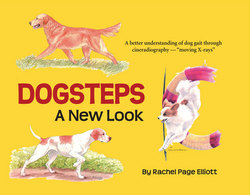Читать книгу Dogsteps - Rachel Page Elliott - Страница 6
На сайте Литреса книга снята с продажи.
ОглавлениеChapter 1: The Language of Dog Anatomy and Comparative Skeletons
Terms Commonly Used in Describing the Dog’s Outer Appearance
Terms Must Be Understood To Be Meaningful
To make certain that we are all speaking the same language in the pages that follow, skeletal diagrams of the dog, the horse and man are included here. All three of these species share the same scientific nomenclature, but much of the common language used around dogs comes from the paddock. A few words have become misconstrued or ambiguous due to the present gap between dog and horse followers, or through translation from other languages, but most of the parlance remains intact.
In spite of their structural differences—and there are important ones—horses and dogs share much in common, and the principles applying to sound conformation and gait are applicable to both. Both vary in breed type according to purpose, both come in various shapes and sizes, and both exhibit gaiting characteristics that are influenced by the differences. Describing the horse and the dog are such expressions as body balance, smooth or choppy action, steep or sloping shoulders, long or short coupled, well ribbed up, straight of hock or stifle, cowhocks, twisting or sickle hocks, weak or strong pasterns, flipping, pounding, paddling, winging, overreaching, etc.With what other animal is the dog compared so compatibly?
Even so, there are some dog fanciers who talk of their dogs in terms applicable to man—perhaps because of the lack of opportunity for first hand acquaintance with horses. For example, the carpal joint is referred to as the wrist, the stifle joint as the knee, or the hock as the heel; and because the dog is actually a toe-walker, the entire area from hock to paw is spoken of as the foot. The word “hock” is one of the most seriously misconstrued words in the canine language because it is often confused with the rear pastern. Breed standards, in describing conformation, usually call for good or moderate bend of hock. This is a justified qualification, but the unwary newcomer can be easily misled if someone tells him his dog should stand “straight in the hock” (for show purposes), when the reference is actually to the rear pastern.
The double meaning and interchange of terms can be perplexing, but fortunately the confusion is something we can get accustomed to as we gain understanding and confidence. Perhaps of more serious concern are the misleading and conflicting references relating to the way dogs should or should not move. Mindful of this, readers are urged to look into the works on anatomy and locomotion listed on page 125. In spite of their differing opinions, they are a worthwhile addition to a dog owner’s library.
Comparative Anatomical Diagrams
Dog
Horse
Human
Evolution has changed the horse into a weight-carrying animal, chiefly by altering his legs from the hock and knee down. He used to walk on four toes in front and three in back, but now walks on a single toe in each foot. Though there is but a semblance of some of the original bones left in his legs, the scientific names remain, and horses and dogs still share the same principles of locomotion. Notice the horse’s greater number of ribs, in contrast to the dog.
Code to the gait diagrams in this book:
